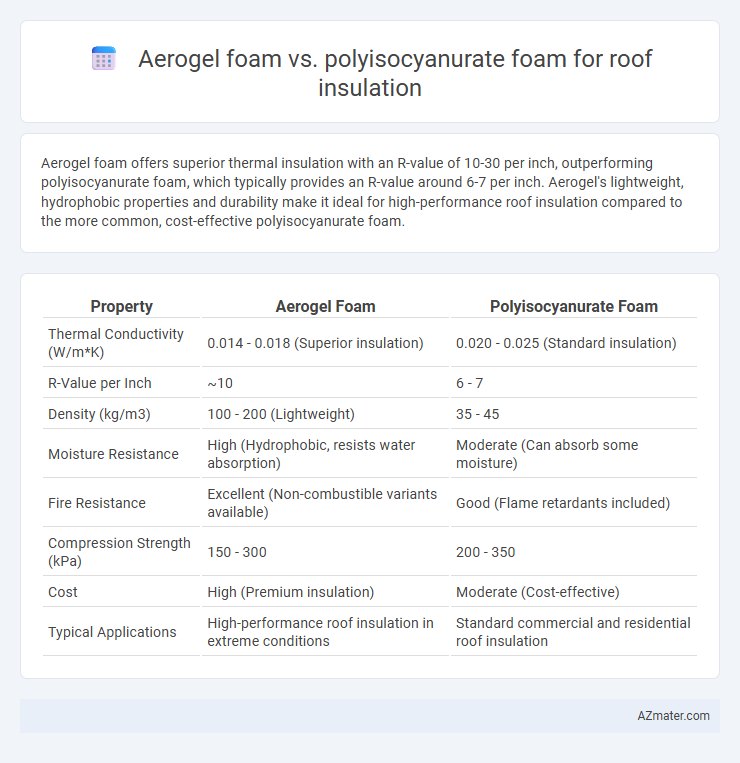Aerogel foam offers superior thermal insulation with an R-value of 10-30 per inch, outperforming polyisocyanurate foam, which typically provides an R-value around 6-7 per inch. Aerogel's lightweight, hydrophobic properties and durability make it ideal for high-performance roof insulation compared to the more common, cost-effective polyisocyanurate foam.
Table of Comparison
| Property | Aerogel Foam | Polyisocyanurate Foam |
|---|---|---|
| Thermal Conductivity (W/m*K) | 0.014 - 0.018 (Superior insulation) | 0.020 - 0.025 (Standard insulation) |
| R-Value per Inch | ~10 | 6 - 7 |
| Density (kg/m3) | 100 - 200 (Lightweight) | 35 - 45 |
| Moisture Resistance | High (Hydrophobic, resists water absorption) | Moderate (Can absorb some moisture) |
| Fire Resistance | Excellent (Non-combustible variants available) | Good (Flame retardants included) |
| Compression Strength (kPa) | 150 - 300 | 200 - 350 |
| Cost | High (Premium insulation) | Moderate (Cost-effective) |
| Typical Applications | High-performance roof insulation in extreme conditions | Standard commercial and residential roof insulation |
Introduction to Roof Insulation Materials
Aerogel foam offers exceptional thermal insulation with a low thermal conductivity of around 0.013 W/m*K, making it highly efficient for roof insulation applications. Polyisocyanurate foam, commonly used in commercial roofing, provides a thermal conductivity of approximately 0.02 W/m*K and offers excellent moisture resistance and structural stability. Both materials improve energy efficiency, but aerogel foam excels in space-constrained installations due to its superior insulation performance and lightweight properties.
What is Aerogel Foam?
Aerogel foam is an ultra-lightweight, highly porous material derived from silica, known for its exceptional thermal insulation properties, with a thermal conductivity as low as 0.013 W/m*K. Unlike Polyisocyanurate foam, which typically has a thermal conductivity around 0.021 W/m*K, aerogel foam offers superior insulating performance while maintaining minimal thickness, making it ideal for space-constrained roofing applications. Its hydrophobic nature and high durability also provide enhanced moisture resistance and long-term thermal stability in roof insulation systems.
Understanding Polyisocyanurate (PIR) Foam
Polyisocyanurate (PIR) foam is a high-performance rigid insulation material commonly used in roof insulation, prized for its superior thermal resistance with R-values typically ranging from 6.0 to 7.0 per inch. PIR foam consists of closed-cell polyurethane, enhanced with a fire-retardant additive, offering excellent moisture resistance and dimensional stability under fluctuating temperatures. Compared to aerogel foam, PIR foam provides a cost-effective solution with good structural strength and widespread commercial availability, making it a preferred choice in commercial and residential roofing applications.
Thermal Performance Comparison
Aerogel foam offers superior thermal performance with an exceptionally low thermal conductivity ranging from 0.013 to 0.018 W/m*K, significantly outperforming polyisocyanurate foam, which typically has a thermal conductivity around 0.021 to 0.027 W/m*K. This enables aerogel insulation to achieve higher R-values per inch, providing enhanced energy efficiency in roof applications where space is limited. Polyisocyanurate foam remains a cost-effective option with good thermal resistance but does not match the ultra-low heat transfer capabilities of aerogel foam.
Moisture and Water Resistance
Aerogel foam exhibits superior moisture and water resistance due to its highly porous, hydrophobic structure, preventing water absorption and maintaining thermal performance even in damp conditions. Polyisocyanurate foam, while offering good initial water resistance, can degrade over time when exposed to prolonged moisture, leading to reduced insulation efficiency and potential structural damage. Selecting aerogel foam for roof insulation enhances durability and energy efficiency by minimizing moisture-related issues.
Fire Resistance and Safety Aspects
Aerogel foam exhibits superior fire resistance with a high ignition temperature above 650degC and low smoke production, making it a safer option for roof insulation compared to polyisocyanurate foam. Polyisocyanurate foam, while offering good thermal insulation, tends to combust more readily and emits toxic gases such as hydrogen cyanide when exposed to fire. Choosing aerogel foam enhances overall safety due to its excellent fire retardant properties and minimal contribution to flame spread.
Installation Process and Practical Considerations
Aerogel foam offers superior thermal insulation with a thinner profile, making it ideal for retrofit projects where space is limited, but requires careful handling due to its fragility and higher cost. Polyisocyanurate foam is easier to install with standard roofing tools, providing robust mechanical strength and moisture resistance, suitable for new constructions and larger-scale applications. Practical considerations include aerogel's longer drying time and specialized installation techniques versus polyisocyanurate's widespread availability and faster application process.
Cost Comparison: Aerogel vs Polyisocyanurate Foam
Aerogel foam typically costs significantly more than polyisocyanurate foam, with price differences driven by advanced manufacturing processes and superior thermal performance. Polyisocyanurate foam remains a more budget-friendly option for large-scale roof insulation projects, offering a balance of cost efficiency and good R-value per inch. While aerogel's premium cost is justified by its ultra-high insulation value and thin profile, polyisocyanurate provides effective thermal resistance at a fraction of the price, making it preferred for cost-sensitive applications.
Sustainability and Environmental Impact
Aerogel foam offers superior thermal insulation with a significantly lower environmental footprint due to its high efficiency, reducing energy consumption and greenhouse gas emissions in buildings. Polyisocyanurate foam, while effective in thermal resistance, often relies on petrochemical-based materials and blowing agents with high global warming potential, raising concerns about long-term sustainability. The biodegradability and recyclability of aerogel foam further enhance its environmental advantages compared to the more challenging disposal and potential off-gassing issues associated with polyisocyanurate insulation.
Which Is Better for Roof Insulation?
Aerogel foam offers superior thermal insulation with R-values up to 10 per inch, significantly outperforming polyisocyanurate foam, which typically provides R-values around 7 per inch. Aerogel's exceptional permeability control and resistance to moisture infiltration reduce energy loss and enhance roof durability, making it ideal for high-performance applications. However, polyisocyanurate is more cost-effective and widely used in commercial roofing due to its established performance and ease of installation.

Infographic: Aerogel foam vs Polyisocyanurate foam for Roof insulation
 azmater.com
azmater.com